Amazing Facts About the Honey Bee: Nature’s Essential Pollinator
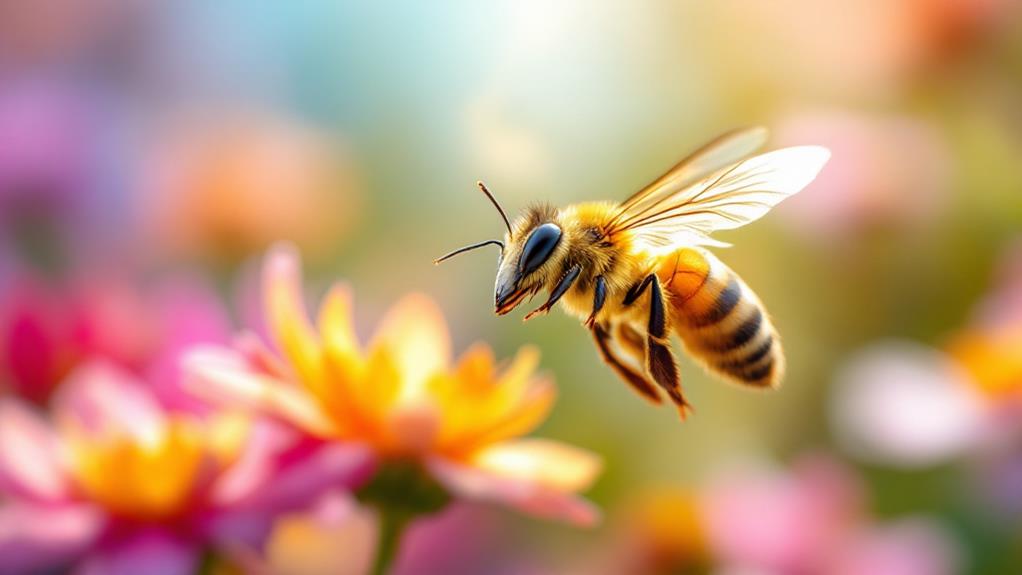
Honey bees are nature's powerhouse pollinators, enhancing about one-third of our food supply by ensuring plants reproduce and thrive. You'll find them organized in colonies with complex social structures where worker bees, drones, and a queen manage diverse tasks like foraging and hive maintenance. Their navigation skills are outstanding, using the sun and landmarks for precise travel. Honey bees communicate through the unique waggle dance and pheromones, keeping their hive alert and informed. However, they're under threat from pesticides, habitat loss, and climate change. To uncover more fascinating aspects of these vital creatures, stick around for insights.
The Role of Honey Bees
Buzzing through gardens and fields, honey bees play an integral role in our ecosystem. As a key pollinator, you'll find these busy creatures actively transferring pollen from flower to flower, guaranteeing plants produce fruits and seeds. This pollination process is vital for the growth of many crops, which in turn supports food production for humans and animals alike. Without honey bees, you'd notice a significant decline in the availability of fresh produce.
Understanding hive dynamics is fundamental to grasp the role of honey bees fully. Each hive is a lively community, where every bee has a specific job. You'll see worker bees collecting nectar and pollen, while drones and the queen fulfill their unique purposes. This organized division of labor optimizes efficiency within the hive, allowing bees to perform their ecological duties effectively.
Bee behavior is fascinating and directly impacts their role as pollinators. You might observe their waggle dance, a communication method that helps bees share information about food sources. This behavior guarantees their survival and promotes biodiversity. By supporting pollination, honey bees help maintain the balance of ecosystems, making their role irreplaceable in nature's intricate web.
Complex Social Structures
Honey bee colonies thrive on complex social structures that guarantee their survival and efficiency. When you look closer, you'll see a fascinating bee hierarchy at work. At the top, the queen bee rules the hive. Her primary role is to lay thousands of eggs, ensuring the colony's growth and sustainability. Her pheromones also maintain harmony and unity within the hive. But she's not alone in this task.
Worker bees, who are all female, perform diverse critical colony roles. They manage everything from foraging for nectar and pollen, constructing and cleaning the hive, to taking care of the brood. Each worker bee's role can change as she matures, illustrating the hive's dynamic adaptability. You'll find that the youngest bees often start as nurse bees, caring for larvae, before becoming foragers in their later life stages.
Drones, the male bees, have a simpler life. Their main role is to mate with a queen from another hive. After mating season, they don't contribute to the hive and are often expelled to conserve resources. Understanding these distinct roles helps you appreciate how each bee contributes to the well-being and efficiency of their colony.
Incredible Navigation Skills
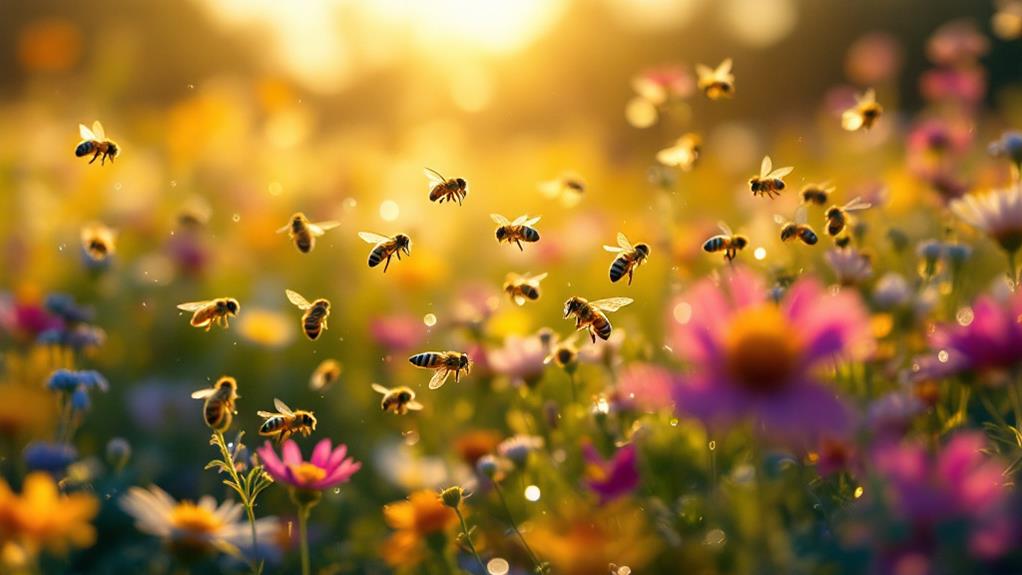
When you observe honey bees, their incredible navigation skills become evident. These tiny creatures possess a remarkable ability to find their way back to the hive after foraging miles away. Hive navigation involves a complex understanding of the landscape, enabling bees to pinpoint their location using the sun, polarized light patterns, and even Earth's magnetic field. You'd be amazed at how they remember intricate details of the environment, such as landmarks and the position of the sun, to guide them home.
Honey bees employ sophisticated foraging strategies, making them efficient pollinators. They plan their trips with precision, always optimizing the distance traveled to conserve energy. As a bee ventures out, it uses a combination of visual cues and olfactory signals to locate flowers rich in nectar and pollen. Once a foraging bee finds a bountiful source, it marks the spot with pheromones, making it easier to return.
Even when conditions change or obstacles arise, bees quickly adapt, altering their route to guarantee they reach their destination. Their ability to navigate complex terrains and coordinate their movements is essential to their survival and the ecological services they provide.
Amazing Communication Methods
As you marvel at the bees' navigation skills, their communication methods are likewise astounding. Imagine a lively beehive, where thousands of bees work in harmony. The secret to their coordination lies in two primary methods: the waggle dance and pheromone signals. The waggle dance is a fascinating form of communication. When a forager bee finds a rich food source, it returns to the hive and performs a dance on the honeycomb. By waggling its body and moving in specific patterns, the bee conveys precise information about the location and distance of the food source relative to the sun. This dance empowers other bees to find the nectar quickly and efficiently.
Pheromone signals are another vital communication tool in a bee's repertoire. Bees release these chemical signals to share information about threats, reproductive status, and hive health. For instance, the queen bee emits a unique pheromone that helps maintain social order and signals her presence within the hive. Worker bees also use pheromones to alert others to potential dangers or to signal when it's time to swarm. By combining these sophisticated communication methods, bees guarantee the hive's success and survival.
Life Cycle of a Worker Bee
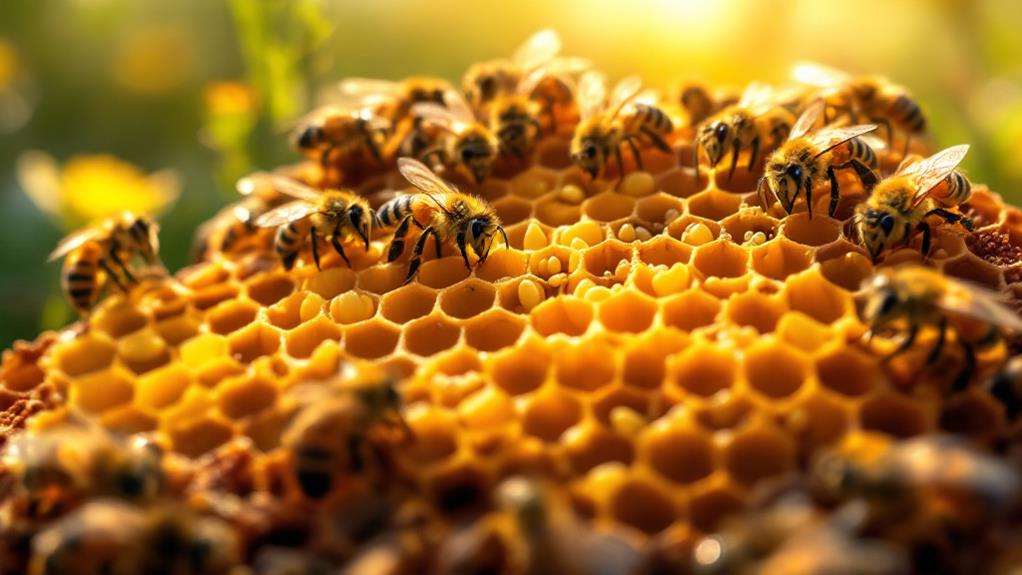
Although the life of a worker bee is short, it is incredibly structured and purposeful. From the moment she hatches, her roles within the hive are clearly defined. At the outset, a worker bee emerges from her egg after a careful egg development process lasting about three days. Your heart might skip a beat when you realize how these tiny creatures begin their expedition.
- Nurse Duties: In her initial few days, she tends to the queen and larvae, ensuring their survival by feeding them royal jelly. This nurturing phase highlights her devotion to the hive's future.
- Hive Maintenance: She then shifts to cleaning and building honeycombs. Her diligence in maintaining the hive's cleanliness is crucial for the colony's health and efficiency.
- Guarding the Entrance: As she matures, her role shifts to guarding the hive. She becomes a steadfast protector, defending against intruders and keeping her sisters safe.
- Foraging Behavior: Ultimately, she spends her remaining days foraging for nectar and pollen. This is where her tireless work impacts the world, as she unknowingly pollinates countless plants and flowers.
Each stage of her life is a reflection of her dedication, despite the brevity of her existence.
Honey Production Process
The magic of honey production begins with a worker bee's incredible foraging expedition. You witness a bee collecting nectar from flowers, which she stores in her honey stomach. This nectar is then transported back to the hive. Inside the hive, she passes the nectar to other worker bees, who chew it, breaking down its complex sugars. This process transforms the nectar into honey. The bees then deposit this honey into the hexagonal cells of the honeycomb.
Next, you observe beeswax production unfold. Worker bees secrete beeswax from special glands on their abdomen. They chew these wax scales, molding them to build and maintain the honeycomb structure. This beeswax is vital as it provides the storage space for honey.
Once the honey is sufficiently dehydrated, bees seal the honey-filled cells with a thin layer of beeswax, preserving it for future use. When it's time for honey extraction, beekeepers carefully remove the honeycomb frames. They use a honey extractor, a centrifugal device, to spin out the honey without damaging the beeswax structure. This careful process guarantees that bees can continue their honey production cycle seamlessly.
Importance of Pollination
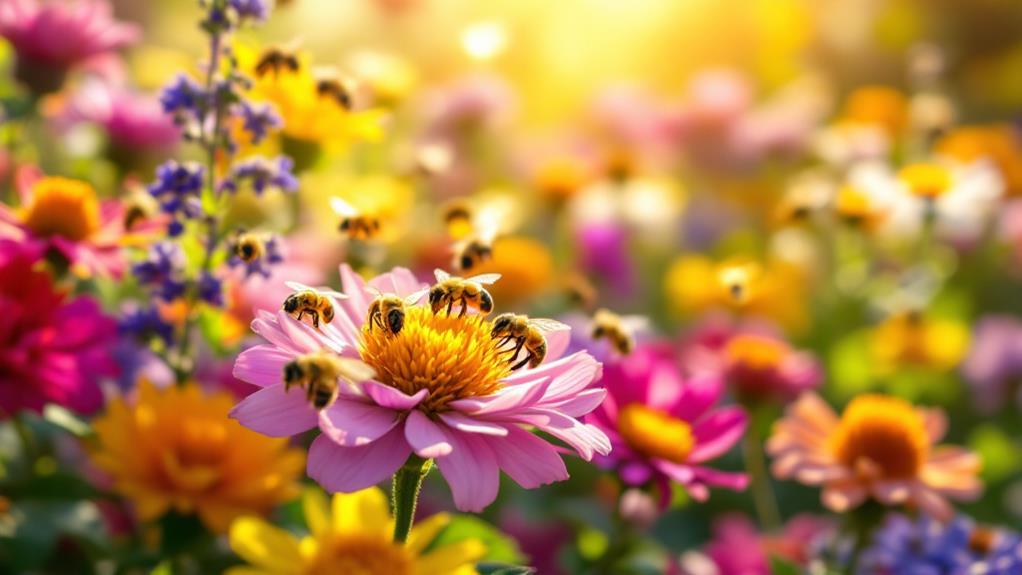
Understanding the significance of pollination can transform how we view these incredible insects. Honey bees play an vital role in maintaining our planet's ecosystem balance. You'll find that their pollination benefits are vast and critical for both nature and humanity. Without honey bees, many plants would struggle to reproduce, affecting food supplies and biodiversity.
Imagine a world without honey bees—it's a much different place. Here are some important reasons why their pollination matters:
- Food Production: Honey bees pollinate crops that make up about one-third of the food you eat. Without them, many fruits, vegetables, and nuts would vanish from our tables.
- Biodiversity: Bees contribute to the genetic diversity of plants. Diverse plant life supports numerous animal species, promoting a rich and balanced ecosystem.
- Economic Impact: The agricultural industry heavily relies on bee pollination, contributing billions to the economy. Farmers and growers depend on bees to produce high-quality crops.
- Environmental Health: Pollination helps sustain healthy habitats for countless species, ensuring the natural world remains colorful and resilient.
Realizing these pollination benefits can inspire you to cherish and protect honey bees, ensuring they continue to thrive and sustain life on Earth.
Threats to Honey Bees
Recognizing the vital contributions honey bees make to pollination, it's alarming to contemplate the numerous threats they face today. One significant issue is the pesticide impact. Many farmers use chemicals to protect crops, but these pesticides can be toxic to bees, affecting their health and survival. You might not realize it, but habitat loss also poses a serious risk. As urban areas expand, bees lose their natural environments where they forage and nest.
Climate change is another challenge. It disrupts blooming cycles, temperatures, and weather patterns, making it harder for bees to find food and maintain their hives. You can imagine how these changes can confuse bees, leading to a decline in their populations. Disease threats like the Varroa mite further exacerbate their plight, weakening colonies and making them more susceptible to viruses.
Monoculture farming, where large areas are planted with a single crop, reduces the diversity of flowers bees rely on. This lack of variety can lead to nutritional deficiencies for honey bees, impacting their ability to thrive. It's vital to understand these threats to appreciate the fragile world bees navigate daily and the significant need to address these challenges.
Conservation Efforts
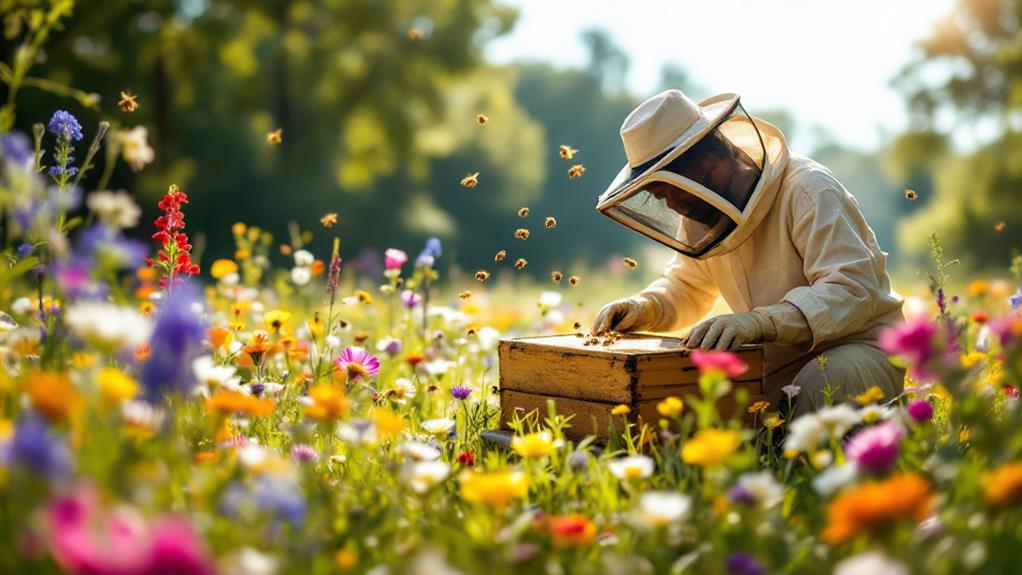
Efforts to conserve honey bee populations are vital in the face of the many threats they encounter. As you consider these efforts, keep in mind that honey bees play an important role in pollinating the plants that sustain us. Without them, the world would face dire consequences. You can make a difference in honey bee conservation by focusing on a few key areas:
- Habitat Preservation: Support initiatives that create and maintain bee-friendly environments. Plant wildflowers and shrubs that attract and nourish bees, and encourage others to do the same. Every patch of preserved habitat counts.
- Pesticide Reduction: Advocate for the use of bee-safe alternatives to harmful pesticides. You can educate yourself and others about the impact of chemicals on bee health and promote organic farming practices in your community.
- Supporting Local Beekeepers: Purchase local honey and hive products to help beekeepers maintain their colonies. Your actions can empower those who are directly involved in honey bee care.
- Raising Awareness: Share information about honey bee conservation with friends, family, and social networks. Every voice counts in raising awareness about the importance of these pollinators.
Your support of these efforts can help guarantee a thriving future for honey bees and, in turn, our planet.
Honey Bee Trivia
Did you know that honey bees, often seen buzzing around gardens and fields, are fascinating creatures with some surprising traits? For instance, a common honey bee myth is that they die as soon as they sting you. While this is true for worker bees, it doesn't apply to all bee species. Another myth is that bees are aggressive by nature. In reality, honey bees are generally peaceful and will only sting when they feel threatened.
Honey bee symbolism is rich and varied across cultures. In ancient Egypt, they symbolized royalty and power. The Greeks saw them as a symbol of industry and hard work, thanks to their relentless efforts in pollination and honey production. In modern times, honey bees represent community and cooperation, as they work together in hives with incredible coordination and efficiency.
Here's a fun fact: a single honey bee visits up to 100 flowers during one foraging trip, which greatly contributes to the pollination of plants. Also, to make one pound of honey, bees need to visit about two million flowers. Next time you see a honey bee, remember these intriguing tidbits and appreciate their crucial role in nature.



